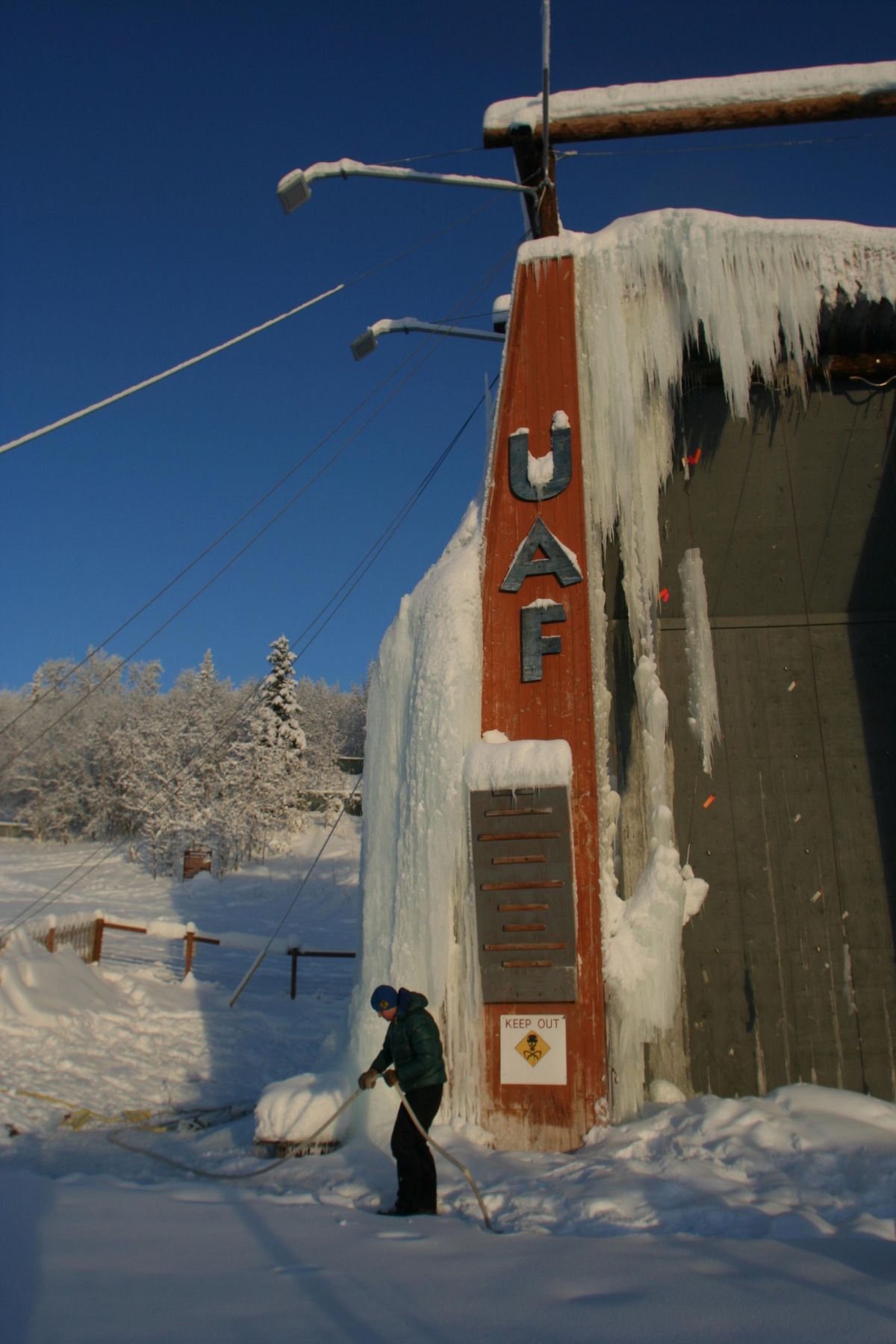University ice makers get the hang of producing climbable walls

Even to non-ice climbers, the ice hanging from the wall at the University of Alaska Fairbanks looks different than it did when the wall opened in 2012.
Today, the ice hanging from the northern and western faces of the 35-foot tower resembles a frozen waterfall, made of columns of bluish-white ice. When the wall opened, it looked less like a waterfall and more like a tower of vegetables: goopy white blobs of what the ice makers called “cauliflower ice.”
“The main difference between what made the cauliflowers and what we switched to was the amount of pressure,” said Christian Mogensen, climbing facility manager with the university’s Department of Recreation Adventure and Wellness. “It was sprayed at a pretty high amount of pressure and that would create mist that would just circulate and create these cauliflowers. Now it’s as low of a trickle as we can get it, and it just builds like a natural waterfall.”
The cauliflower ice was weak, which made it much too easy to sink an ax into – a poor preparation for climbing natural ice.
Mogensen and Brandon Worthington, Outdoor Adventures coordinator, are in charge of building the ice for the climbing wall. They call their current technique “version 3.2.8.”
Creating ice for a climbing tower has been a trial-and-error process because university staff who built the wall didn’t have a model to follow like the well-established techniques for building rock climbing walls.
As far as the staff here is aware, the University of Alaska Fairbanks campus was the first and remains the only college in the U.S. with a man-made ice climbing wall on campus. However, man-made ice walls in general aren’t without precedent. There used to be a private ice climbing tower north of Fairbanks in Fox.
The university’s outdoor ice and rock climbing wall were part of a burst in funding for outdoor facilities at the university that came before Alaska’s current fiscal crisis. The expansion also included the Hulbert Nanook Terrain Park, a ski and snowboard park on campus that was moved to Ski Land on the Steese Highway under a deal that gave students season passes to the downhill ski area for five years.
When the UAF ice wall opened in 2012, staff used a series of fixed nozzles at the top of the wall to drip water down the face. After spraying, staff planned to purge the water from the line, but enough moisture remained that the pipes froze. The wall closed for repairs not long after its grand opening.
The next method involved spraying the wall with a snow gun. This worked, but the ice was of poor quality and extremely slow to form. Staff would sometimes work all night building ice, moving the position of the snow gun every 45 minutes.
A student worker once borrowed a cold-weather sleeping bag to camp below the tower while building ice. His boss came into work in the morning and found him curled up in a crusty frozen bag.
The wall staff began its current technique about four years ago. It involves an improvised apparatus that builds ice relatively quickly and can be hauled inside when not in use. The apparatus is composed of a 2x4, a firefighting hose, some nozzles and plastic sheeting. Water falls down from the nozzles and over the plastic sheeting to simulate the slow drip-drip-drip of a freezing waterfall. The whole apparatus is put on a pulley to be moved to the section of the wall that needs new ice.
Unlike a freezing waterfall, the water must flow to the top of the tower through a hose before it drips down. On a 26 below zero morning last week, Worthington and Mogensen struggled with an apparatus that froze quickly despite having been stored indoors. As they turned on the tap, the water flowed sluggishly into the hose, taking a slushy consistency. As the sun rose over the university, they worked on the shady northern side of the tower, jumping on the hose and breaking up the nozzle with a metal rod to get the water flowing.
It’s hard to make ice on cold days, but warm days are also no good. When the ambient temperature is higher than roughly 15 degrees, the warm university tap water destroys ice faster than it makes it. The next innovation for their apparatus will likely be a radiator system that cools the water to about 40 degrees before piping it to the top of the wall.
Not many people take advantage of the hard work of the ice-making crew. Even with better-quality ice, the ice wall doesn’t get much use, unlike the university rock climbing facilities, which are sometimes near capacity. Ice climbing is a niche sport. Most days only a handful of people climb the wall. On the warmest Saturday in March, as many as two dozen people may come to climb. But compared with the climbers who first tried the wall when it opened, those who climb today get a much better experience, Worthington said.